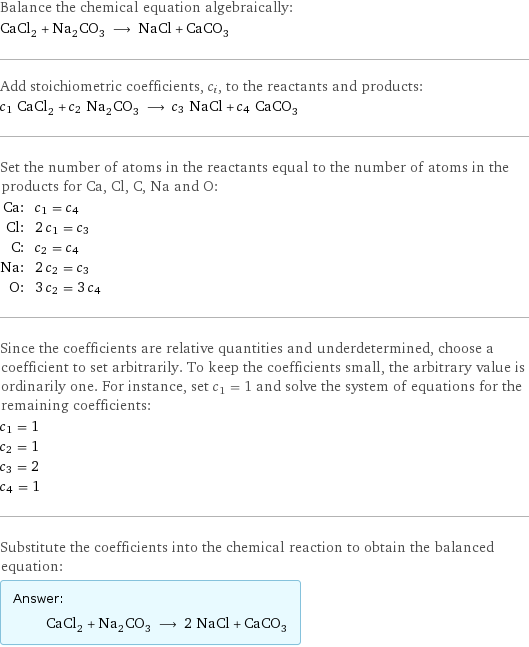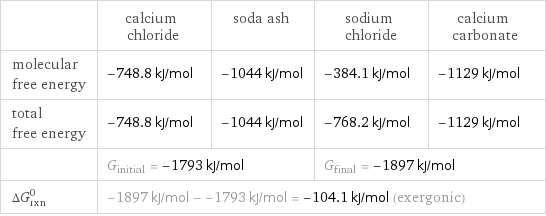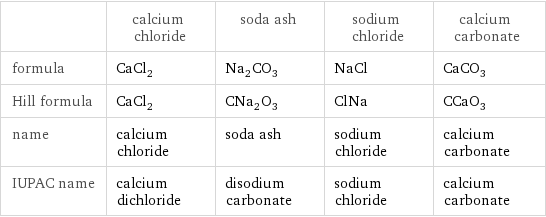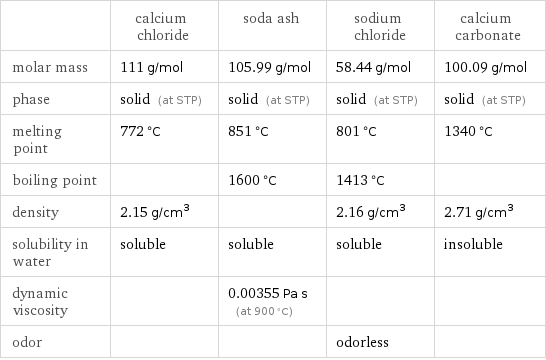Input interpretation

CaCl_2 (calcium chloride) + Na_2CO_3 (soda ash) ⟶ NaCl (sodium chloride) + CaCO_3 (calcium carbonate)
Balanced equation

Balance the chemical equation algebraically: CaCl_2 + Na_2CO_3 ⟶ NaCl + CaCO_3 Add stoichiometric coefficients, c_i, to the reactants and products: c_1 CaCl_2 + c_2 Na_2CO_3 ⟶ c_3 NaCl + c_4 CaCO_3 Set the number of atoms in the reactants equal to the number of atoms in the products for Ca, Cl, C, Na and O: Ca: | c_1 = c_4 Cl: | 2 c_1 = c_3 C: | c_2 = c_4 Na: | 2 c_2 = c_3 O: | 3 c_2 = 3 c_4 Since the coefficients are relative quantities and underdetermined, choose a coefficient to set arbitrarily. To keep the coefficients small, the arbitrary value is ordinarily one. For instance, set c_1 = 1 and solve the system of equations for the remaining coefficients: c_1 = 1 c_2 = 1 c_3 = 2 c_4 = 1 Substitute the coefficients into the chemical reaction to obtain the balanced equation: Answer: | | CaCl_2 + Na_2CO_3 ⟶ 2 NaCl + CaCO_3
Structures

+ ⟶ +
Names

calcium chloride + soda ash ⟶ sodium chloride + calcium carbonate
Reaction thermodynamics
Enthalpy

| calcium chloride | soda ash | sodium chloride | calcium carbonate molecular enthalpy | -795.4 kJ/mol | -1131 kJ/mol | -411.2 kJ/mol | -1208 kJ/mol total enthalpy | -795.4 kJ/mol | -1131 kJ/mol | -822.4 kJ/mol | -1208 kJ/mol | H_initial = -1926 kJ/mol | | H_final = -2030 kJ/mol | ΔH_rxn^0 | -2030 kJ/mol - -1926 kJ/mol = -103.9 kJ/mol (exothermic) | | |
Gibbs free energy

| calcium chloride | soda ash | sodium chloride | calcium carbonate molecular free energy | -748.8 kJ/mol | -1044 kJ/mol | -384.1 kJ/mol | -1129 kJ/mol total free energy | -748.8 kJ/mol | -1044 kJ/mol | -768.2 kJ/mol | -1129 kJ/mol | G_initial = -1793 kJ/mol | | G_final = -1897 kJ/mol | ΔG_rxn^0 | -1897 kJ/mol - -1793 kJ/mol = -104.1 kJ/mol (exergonic) | | |
Equilibrium constant
![Construct the equilibrium constant, K, expression for: CaCl_2 + Na_2CO_3 ⟶ NaCl + CaCO_3 Plan: • Balance the chemical equation. • Determine the stoichiometric numbers. • Assemble the activity expression for each chemical species. • Use the activity expressions to build the equilibrium constant expression. Write the balanced chemical equation: CaCl_2 + Na_2CO_3 ⟶ 2 NaCl + CaCO_3 Assign stoichiometric numbers, ν_i, using the stoichiometric coefficients, c_i, from the balanced chemical equation in the following manner: ν_i = -c_i for reactants and ν_i = c_i for products: chemical species | c_i | ν_i CaCl_2 | 1 | -1 Na_2CO_3 | 1 | -1 NaCl | 2 | 2 CaCO_3 | 1 | 1 Assemble the activity expressions accounting for the state of matter and ν_i: chemical species | c_i | ν_i | activity expression CaCl_2 | 1 | -1 | ([CaCl2])^(-1) Na_2CO_3 | 1 | -1 | ([Na2CO3])^(-1) NaCl | 2 | 2 | ([NaCl])^2 CaCO_3 | 1 | 1 | [CaCO3] The equilibrium constant symbol in the concentration basis is: K_c Mulitply the activity expressions to arrive at the K_c expression: Answer: | | K_c = ([CaCl2])^(-1) ([Na2CO3])^(-1) ([NaCl])^2 [CaCO3] = (([NaCl])^2 [CaCO3])/([CaCl2] [Na2CO3])](../image_source/ed0d9e2e133c87f128e99ee38384e8fa.png)
Construct the equilibrium constant, K, expression for: CaCl_2 + Na_2CO_3 ⟶ NaCl + CaCO_3 Plan: • Balance the chemical equation. • Determine the stoichiometric numbers. • Assemble the activity expression for each chemical species. • Use the activity expressions to build the equilibrium constant expression. Write the balanced chemical equation: CaCl_2 + Na_2CO_3 ⟶ 2 NaCl + CaCO_3 Assign stoichiometric numbers, ν_i, using the stoichiometric coefficients, c_i, from the balanced chemical equation in the following manner: ν_i = -c_i for reactants and ν_i = c_i for products: chemical species | c_i | ν_i CaCl_2 | 1 | -1 Na_2CO_3 | 1 | -1 NaCl | 2 | 2 CaCO_3 | 1 | 1 Assemble the activity expressions accounting for the state of matter and ν_i: chemical species | c_i | ν_i | activity expression CaCl_2 | 1 | -1 | ([CaCl2])^(-1) Na_2CO_3 | 1 | -1 | ([Na2CO3])^(-1) NaCl | 2 | 2 | ([NaCl])^2 CaCO_3 | 1 | 1 | [CaCO3] The equilibrium constant symbol in the concentration basis is: K_c Mulitply the activity expressions to arrive at the K_c expression: Answer: | | K_c = ([CaCl2])^(-1) ([Na2CO3])^(-1) ([NaCl])^2 [CaCO3] = (([NaCl])^2 [CaCO3])/([CaCl2] [Na2CO3])
Rate of reaction
![Construct the rate of reaction expression for: CaCl_2 + Na_2CO_3 ⟶ NaCl + CaCO_3 Plan: • Balance the chemical equation. • Determine the stoichiometric numbers. • Assemble the rate term for each chemical species. • Write the rate of reaction expression. Write the balanced chemical equation: CaCl_2 + Na_2CO_3 ⟶ 2 NaCl + CaCO_3 Assign stoichiometric numbers, ν_i, using the stoichiometric coefficients, c_i, from the balanced chemical equation in the following manner: ν_i = -c_i for reactants and ν_i = c_i for products: chemical species | c_i | ν_i CaCl_2 | 1 | -1 Na_2CO_3 | 1 | -1 NaCl | 2 | 2 CaCO_3 | 1 | 1 The rate term for each chemical species, B_i, is 1/ν_i(Δ[B_i])/(Δt) where [B_i] is the amount concentration and t is time: chemical species | c_i | ν_i | rate term CaCl_2 | 1 | -1 | -(Δ[CaCl2])/(Δt) Na_2CO_3 | 1 | -1 | -(Δ[Na2CO3])/(Δt) NaCl | 2 | 2 | 1/2 (Δ[NaCl])/(Δt) CaCO_3 | 1 | 1 | (Δ[CaCO3])/(Δt) (for infinitesimal rate of change, replace Δ with d) Set the rate terms equal to each other to arrive at the rate expression: Answer: | | rate = -(Δ[CaCl2])/(Δt) = -(Δ[Na2CO3])/(Δt) = 1/2 (Δ[NaCl])/(Δt) = (Δ[CaCO3])/(Δt) (assuming constant volume and no accumulation of intermediates or side products)](../image_source/7f1319b21feda6c9f550c1e7ac8a3fb6.png)
Construct the rate of reaction expression for: CaCl_2 + Na_2CO_3 ⟶ NaCl + CaCO_3 Plan: • Balance the chemical equation. • Determine the stoichiometric numbers. • Assemble the rate term for each chemical species. • Write the rate of reaction expression. Write the balanced chemical equation: CaCl_2 + Na_2CO_3 ⟶ 2 NaCl + CaCO_3 Assign stoichiometric numbers, ν_i, using the stoichiometric coefficients, c_i, from the balanced chemical equation in the following manner: ν_i = -c_i for reactants and ν_i = c_i for products: chemical species | c_i | ν_i CaCl_2 | 1 | -1 Na_2CO_3 | 1 | -1 NaCl | 2 | 2 CaCO_3 | 1 | 1 The rate term for each chemical species, B_i, is 1/ν_i(Δ[B_i])/(Δt) where [B_i] is the amount concentration and t is time: chemical species | c_i | ν_i | rate term CaCl_2 | 1 | -1 | -(Δ[CaCl2])/(Δt) Na_2CO_3 | 1 | -1 | -(Δ[Na2CO3])/(Δt) NaCl | 2 | 2 | 1/2 (Δ[NaCl])/(Δt) CaCO_3 | 1 | 1 | (Δ[CaCO3])/(Δt) (for infinitesimal rate of change, replace Δ with d) Set the rate terms equal to each other to arrive at the rate expression: Answer: | | rate = -(Δ[CaCl2])/(Δt) = -(Δ[Na2CO3])/(Δt) = 1/2 (Δ[NaCl])/(Δt) = (Δ[CaCO3])/(Δt) (assuming constant volume and no accumulation of intermediates or side products)
Chemical names and formulas

| calcium chloride | soda ash | sodium chloride | calcium carbonate formula | CaCl_2 | Na_2CO_3 | NaCl | CaCO_3 Hill formula | CaCl_2 | CNa_2O_3 | ClNa | CCaO_3 name | calcium chloride | soda ash | sodium chloride | calcium carbonate IUPAC name | calcium dichloride | disodium carbonate | sodium chloride | calcium carbonate
Substance properties

| calcium chloride | soda ash | sodium chloride | calcium carbonate molar mass | 111 g/mol | 105.99 g/mol | 58.44 g/mol | 100.09 g/mol phase | solid (at STP) | solid (at STP) | solid (at STP) | solid (at STP) melting point | 772 °C | 851 °C | 801 °C | 1340 °C boiling point | | 1600 °C | 1413 °C | density | 2.15 g/cm^3 | | 2.16 g/cm^3 | 2.71 g/cm^3 solubility in water | soluble | soluble | soluble | insoluble dynamic viscosity | | 0.00355 Pa s (at 900 °C) | | odor | | | odorless |
Units
